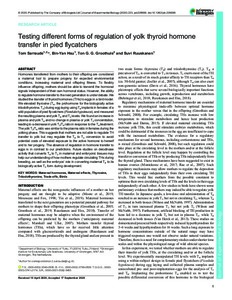Testing different forms of regulation of yolk thyroid hormone transfer in pied flycatchers
Sarraude Tom; Groothuis Ton GG; Hsu Bin-Yav; Ruuskanen Suvi
Testing different forms of regulation of yolk thyroid hormone transfer in pied flycatchers
Sarraude Tom
Groothuis Ton GG
Hsu Bin-Yav
Ruuskanen Suvi
COMPANY BIOLOGISTS LTD
Julkaisun pysyvä osoite on:
https://urn.fi/URN:NBN:fi-fe2021042823649
https://urn.fi/URN:NBN:fi-fe2021042823649
Tiivistelmä
Hormones transferred from mothers to their offspring are considered a maternal tool to prepare progeny for expected environmental conditions, increasing maternal and offspring fitness. To flexibly influence offspring, mothers should be able to transmit the hormonal signals independent of their own hormonal status. However, the ability to regulate hormone transfer to the next generation is under debate. We studied the transfer of thyroid hormones (THs) to eggs in a bird model. We elevated thyroxine (T-4, the prohormone for the biologically active triiodothyronine, T-3) during egg laying using T-4 implants in females of a wild population of pied flycatchers (Ficedula hypoleuca), and measured the resulting plasma and yolk T-4 and T-3 levels. We found an increase in plasma and yolk T-4 and no change in plasma or yolk T-3 concentration, leading to a decrease in yolk T-3/T-4 ratio in response to the T-4 treatment. The yolk T-3/T-4 ratio was similar to the plasma ratio in females during the yolking phase. This suggests that mothers are not able to regulate TH transfer to yolk but may regulate the T-4 to T-3 conversion to avoid potential costs of elevated exposure to the active hormone to herself and to her progeny. The absence of regulation in hormone transfer to eggs is in contrast to our predictions. Future studies on deiodinase activity that converts T-4 to T-3 in maternal and embryonic tissues may help our understanding of how mothers regulate circulating THs during breeding, as well as the embryos' role in converting maternal T-4 to its biologically active T-3 form during development.
Kokoelmat
- Rinnakkaistallenteet [19207]
